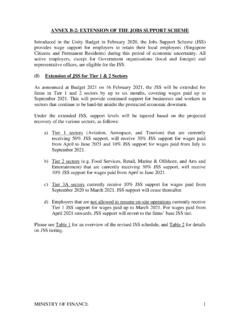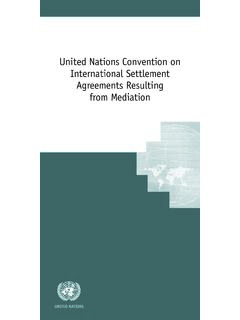Transcription of ANNEX E-1: UPLIFTING LOWER-WAGE WORKERS
1 ANNEX E-1: UPLIFTING LOWER-WAGE WORKERS . The enhancements to Progressive Wages, which include the expanded coverage to new sectors and occupations and the new Local Qualifying Salary requirement, as well as the enhancements to the Workfare Income supplement scheme, will further uplift LOWER-WAGE WORKERS in the years ahead. To provide transitional support for employers in implementing the Progressive Wage moves, the Government will introduce the Progressive Wage Credit Scheme ( PWCS ). PWCS and enhanced Workfare are expected to cost the Government around $9 billion in total over the next five years. (A) UPLIFTING LOWER-WAGE WORKERS A-1: Progressive Wage Credit Scheme PWCS provides transitional support to employers by co-funding wage increases of LOWER-WAGE WORKERS between 2022 and 2026.
2 Employers do not need to apply. The Inland Revenue Authority of Singapore ( IRAS ) will credit payouts for employers that have implemented eligible wage increases into their accounts by the first quarter of the year following the wage increases. The PWCS has the following features: a) Targeted at resident LOWER-WAGE employees with gross monthly wages of up to $2,500. This support will be provided from 2022 to 2026. The qualifying wage ceiling of $2,500 is aligned to that for the enhanced Workfare Income supplement scheme (see Section A-2 below). b) Additional tier of support for employees with gross monthly wages above $2,500. and up to $3,000. In view of the uncertain economic conditions in the immediate term, the Government will provide some support for the wage increases of employees earning above $2,500 and up to $3,000 who marginally miss the first wage tier.
3 This additional support will be provided from 2022 to 2024. c) Average gross monthly wage increase must be at least $100 to be eligible for the PWCS payout in each qualifying year. d) Co-fund wage increases in each qualifying year for two years. For example, a 2022. wage increase will be supported in qualifying year 2022, and also in 2023 if sustained. The approach helps employers manage the compounding effect of wage increases year on year. Table 1 shows the Government co-funding levels. MINISTRY OF FINANCE. Table 1: Government Co-Funding Levels First Tier Second Tier Qualifying Gross Monthly Wage Gross Monthly Wage Payout Period Year Ceiling Ceiling > $2,500 and $2,500 $3,000. 2022 Q1 2023 50% 30%. 2023 Q1 2024 50% 30%. 2024 Q1 2025 30% 15%. 2025 Q1 2026 30% - 2026 Q1 2027 15% - See Section B for illustration of payouts under PWCS.
4 MINISTRY OF FINANCE. A-2: Enhancements to the Workfare Income supplement Scheme The Government will enhance the Workfare Income supplement scheme to supplement the incomes and CPF savings of LOWER-WAGE Singaporean WORKERS , and encourage them to work regularly. Workfare is paid directly to eligible WORKERS . These changes will apply to work done from 1 January 2023. We expect the enhanced Workfare to benefit more than half a million Singaporeans, up from 460,000 today. Employees do not need to apply for Workfare, as eligibility will be automatically assessed based on employers'. CPF contributions. Self-employed persons will have to declare their income, and make the required MediSave contributions to receive Workfare payouts. Changes to Workfare Income supplement Scheme a) Qualifying monthly income cap raised from $2,300 to $2, This takes into account income growth of Singaporeans.
5 B) Extension of Workfare to those aged 30-34. The payouts will help them better cope with their expenses and start saving early for their retirement. c) Higher annual Workfare payouts of up to $4,200. Payouts depend on age and income, and have been enhanced across all age bands. Eligible employees can receive up to $4,200 per year in payouts, compared to $4,000 per year today. Older WORKERS will continue to receive the highest payouts. The payouts for self-employed persons are set at two-thirds of employee payouts and will be correspondingly increased. d) All persons with disabilities will qualify for the highest Workfare payout tier (up to $4,200), regardless of age. e) Minimum qualifying monthly income criterion of $500. To encourage regular employment, Singaporean WORKERS will need to earn at least $500 per month to qualify for Workfare.
6 The payout changes outlined above are summarised in Table 2. 1. In addition, one must earn an average gross monthly income of not more than $2,500 in the past 12 months. MINISTRY OF FINANCE. Table 2: Maximum Annual Workfare Payout for Employees*. Before Enhancement After Enhancement Age Band (For Work Done from (For Work Done from 1 Jan 2020) 1 Jan 2023). 30-34 (new tier) - $2,100. 35-44 $1,700 $3,000. 45-54 $2,500 $3,600. 55-59 $3,300. 60 & above $4,000 $4,200. All persons with Varies by age $4,200. disabilities *The payouts depend on actual incomes. The payouts for self-employed persons are set at two-thirds of employee payouts. More information Scheme Contact Details Progressive Wage Credit Scheme Website: FormSG link: Helpline: 6351 3390. Workfare Income supplement Please contact the CPF Board for more information at MINISTRY OF FINANCE.
7 (B) Illustrations of Support B-1 Employee who earned $1,800 per month in 2021, and experiences average gross monthly wage increase of $100 in January of each year 2021 2022 2023 2024 2025 2026. Average $1,800 $1,900 $2,000 $2,100 $2,200 $2,300. Gross Monthly Wage First Tier (Gross Monthly Wage Ceiling $2,500). PWCS Co- - 50% 50% 30% 30% 15%. Funding Level Wage - $100 $200 $200 $200 $200. Increase ($1,900 - For 2023 = For 2024 = For 2025 = For 2026 =. Eligible for $1,800) $100 $100 $100 $100. PWCS Co- ($2,000 - ($2,100 - ($2,200 - ($2,300 - Funding $1,900) $2,000) $2,100) $2,200). For 2022 = For 2023 = For 2024 = For 2025 =. $100 $100 $100 $100. PWCS Co- - $50 $100 $60 $60 $30. Funding (50% * For 2023 = For 2024 = For 2025 = For 2026 =. $100) $50 (50% * $30 (30% * $30 (30% * $15 (15% *.))))
8 $100) $100) $100) $100). For 2022 = For 2023 = For 2024 = For 2025 =. $50 (50% * $30 (30% * $30 (30% * $15 (15% *. $100) $100) $100) $100). Second Tier (Gross Monthly Wage Ceiling > $2,500 and $3,000). PWCS Co- - $50 $100 $60 $60 $30. Funding Per Month Total PWCS - $600 $1,200 $720 $720 $360. Payout in the ($50 * 12) ($100 * 12) ($60 * 12) ($60 * 12) ($30 * 12). year Notes: [1] As PWCS is effective from 2022, wage increases in 2021 ( increases in 2021 from the 2020 wage) will not be supported by PWCS. [2] Calculation of total PWCS payout in the year assumes that employer makes 12 months of CPF contributions for each qualifying year. MINISTRY OF FINANCE. B-2 Employee who earned $2,200 per month in 2021, and experiences average gross monthly wage increase of $200 in January of each year 2021 2022 2023 2024 2025 2026.
9 Average $2,200 $2,400 $2,600 $2,800 $3,000 $3,200. Gross Monthly Wage First Tier (Gross Monthly Wage Ceiling $2,500). PWCS Co- - 50% 50% 30% 30% 15%. Funding Level Wage - $200 $300 $100 - - Increase ($2,400 - For 2023 = For 2023 =. Eligible for $2,200) $100 $100. PWCS Co- ($2,500 - Funding $2,400). For 2022 =. $200. PWCS Co- - $100 $150 $30 - - Funding (50% * For 2023= For 2023 =. $200) $50 $30. (50% * $100) (30% * $100). For 2022 =. $100. (50% * $200). Second Tier (Gross Monthly Wage Ceiling > $2,500 and $3,000). PWCS Co- - 30% 30% 15% - - Funding Level Wage - - $100 $300 - - Increase For 2023 = For 2024 =. Eligible for $100 $200. PWCS Co- ($2,600 - ($2,800 - Funding $2,500) $2,600). For 2023 =. $100. PWCS Co- - - $30 $45 - - Funding For 2023 = For 2024 =. $30 $30. (30% * $100) (15% * 200).
10 For 2023 =. $15. (15% * $100). PWCS Co- - $100 $180 $75 - - Funding Per Month Total PWCS - $1,200 $2,160 $900 - - Payout in the ($100 * 12) ($180 * 12) ($75 * 12). year MINISTRY OF FINANCE. Notes: [1] As PWCS is effective from 2022, wage increases in 2021 ( increases in 2021 from the 2020 wage) will not be supported by PWCS. [2] Calculation of total PWCS payout in the year assumes that employer makes 12 months of CPF contributions for each qualifying year. B-3 Employee who earned $4,000 per month in 2021, and experiences average gross monthly wage increase of $100 in January of each year PWCS will not co-fund the wage increases of this employee, as the employee is earning above the wage threshold of $3,000. MINISTRY OF FINANCE.



